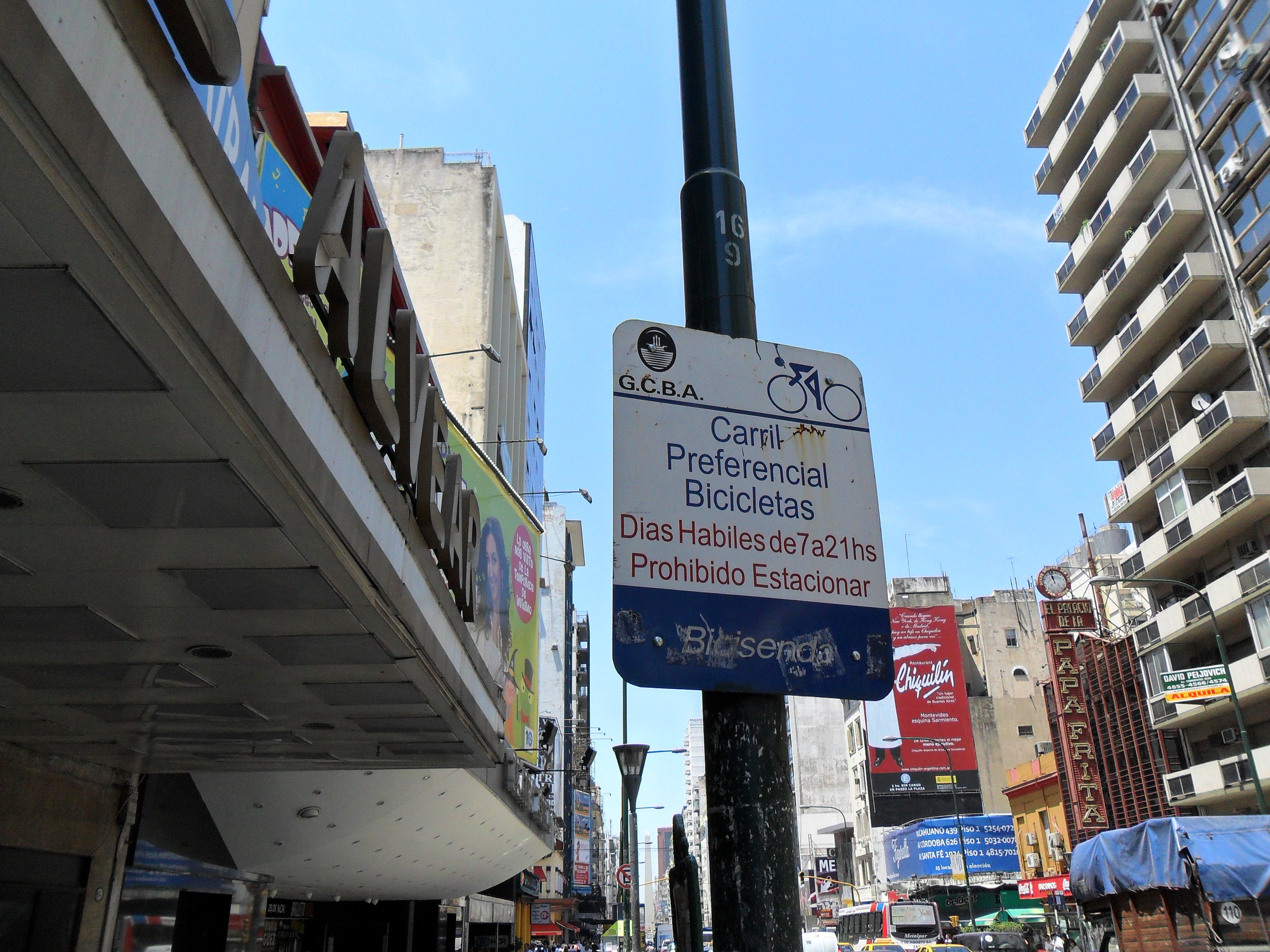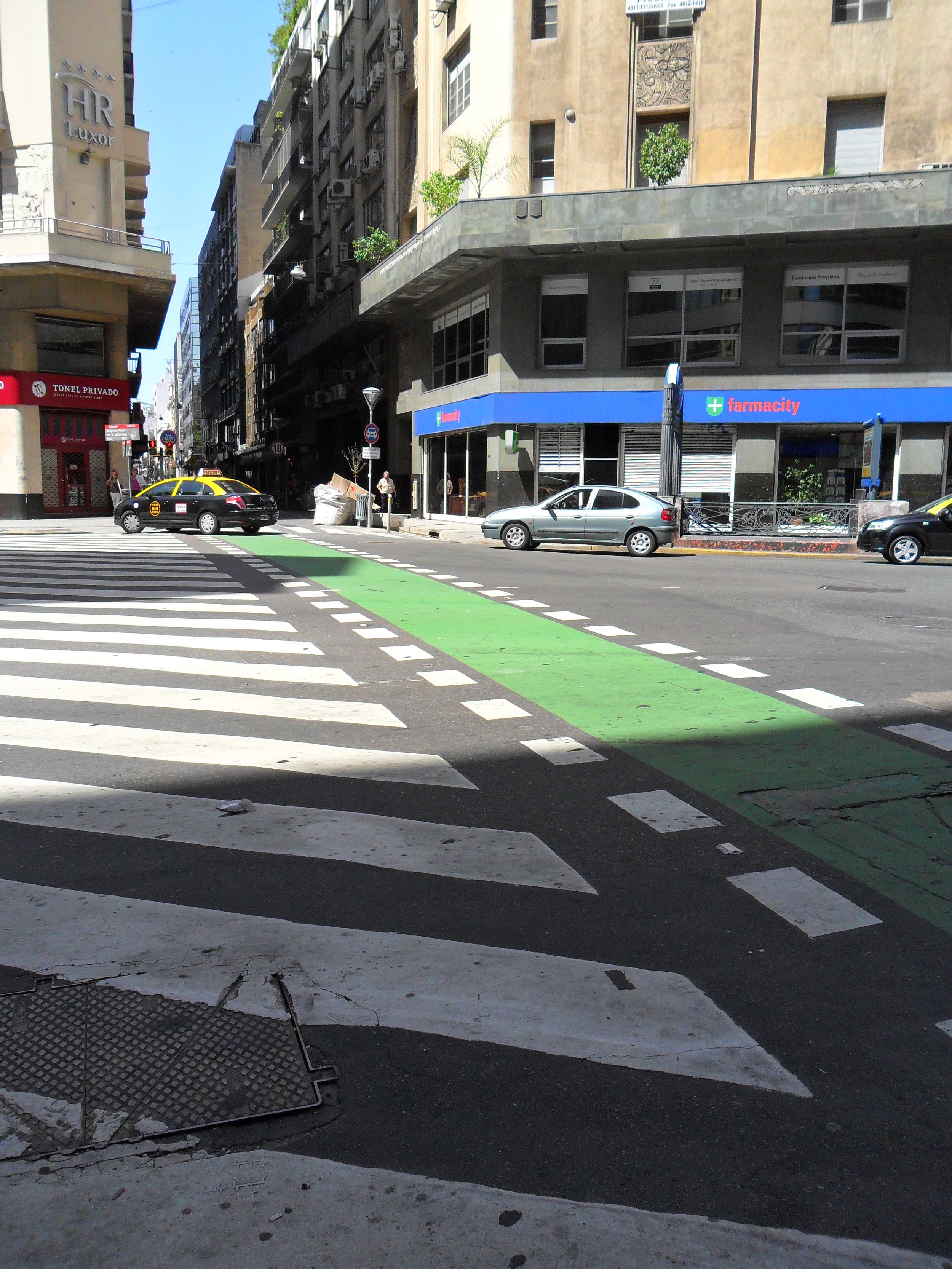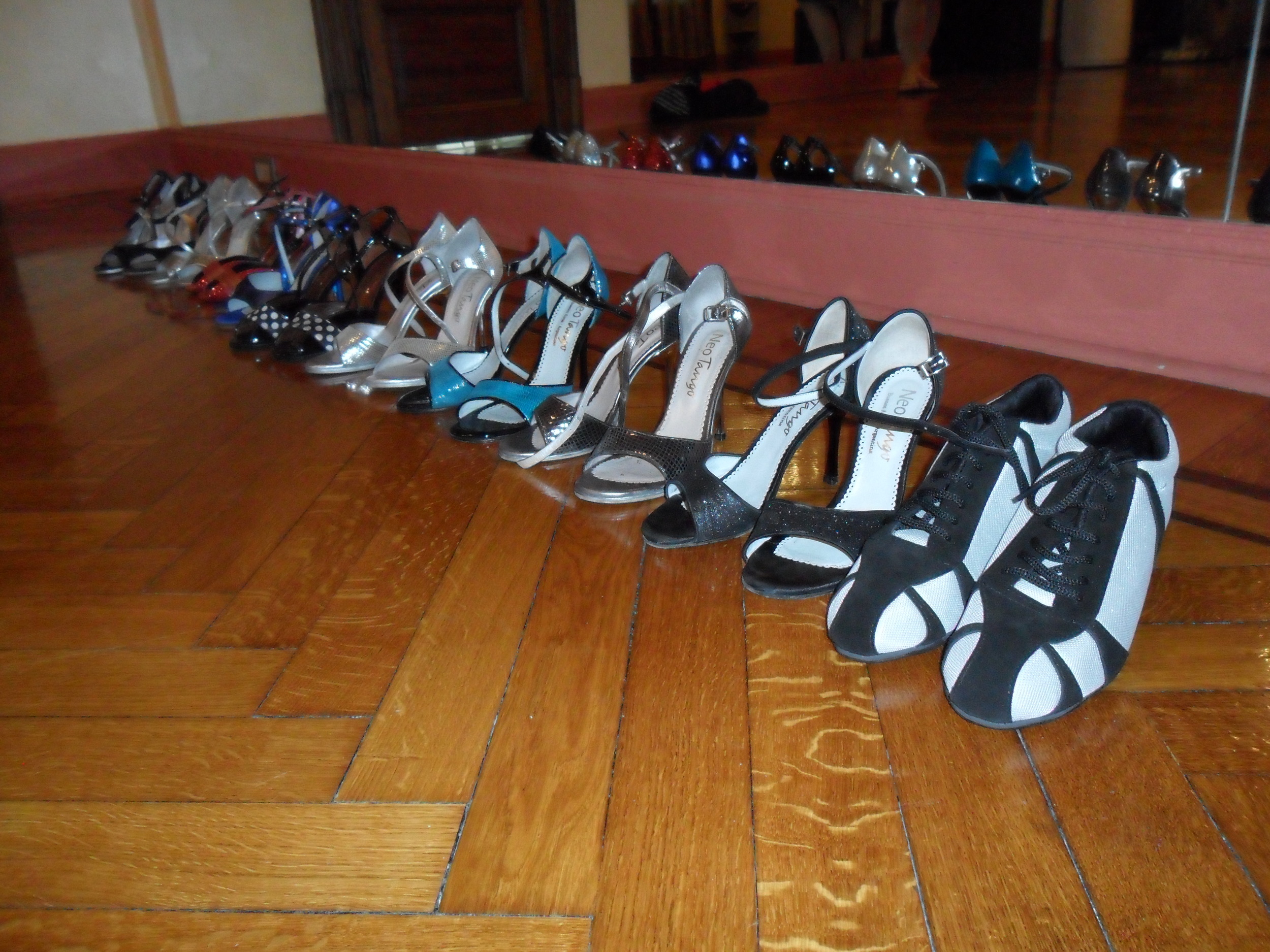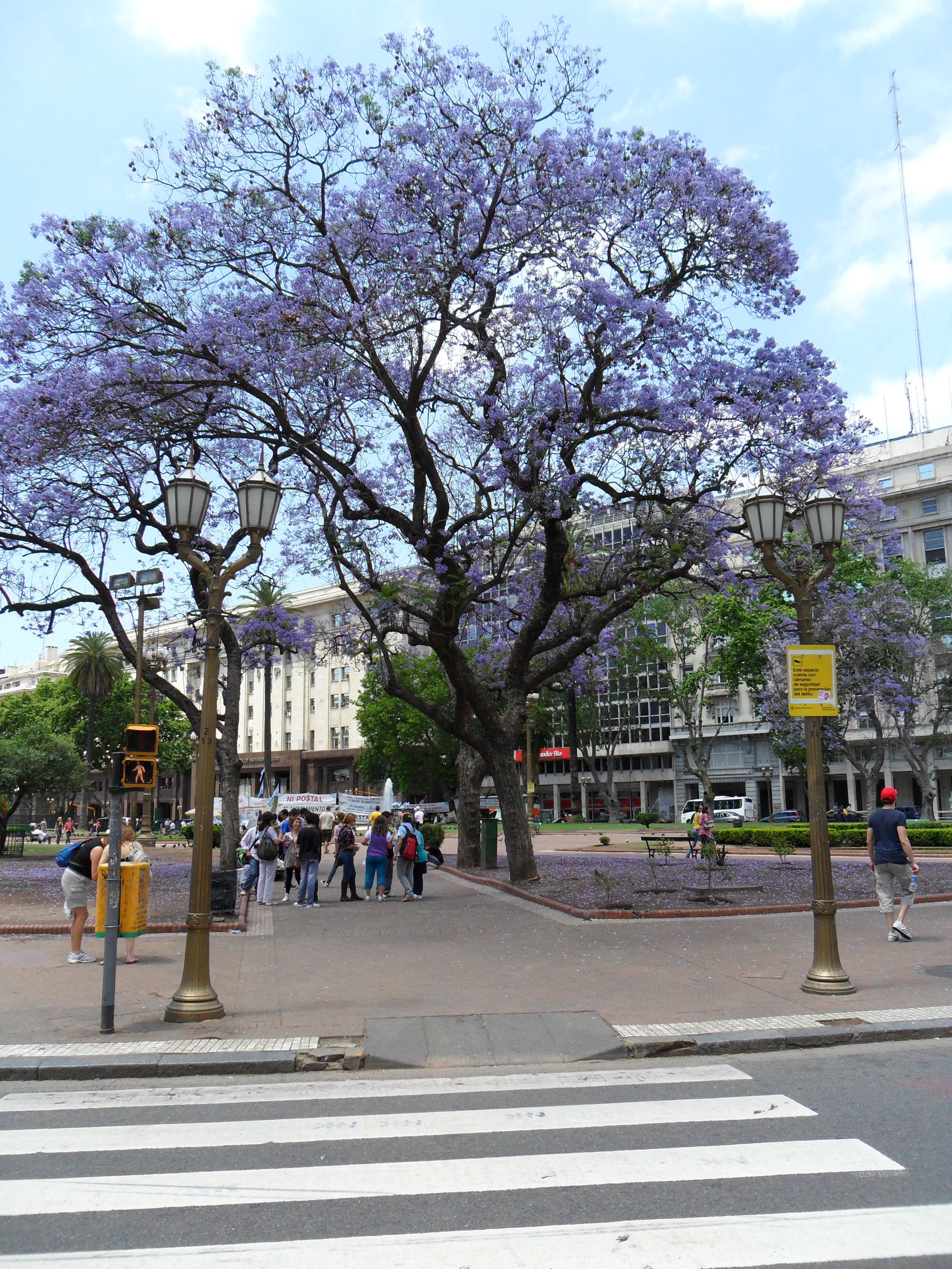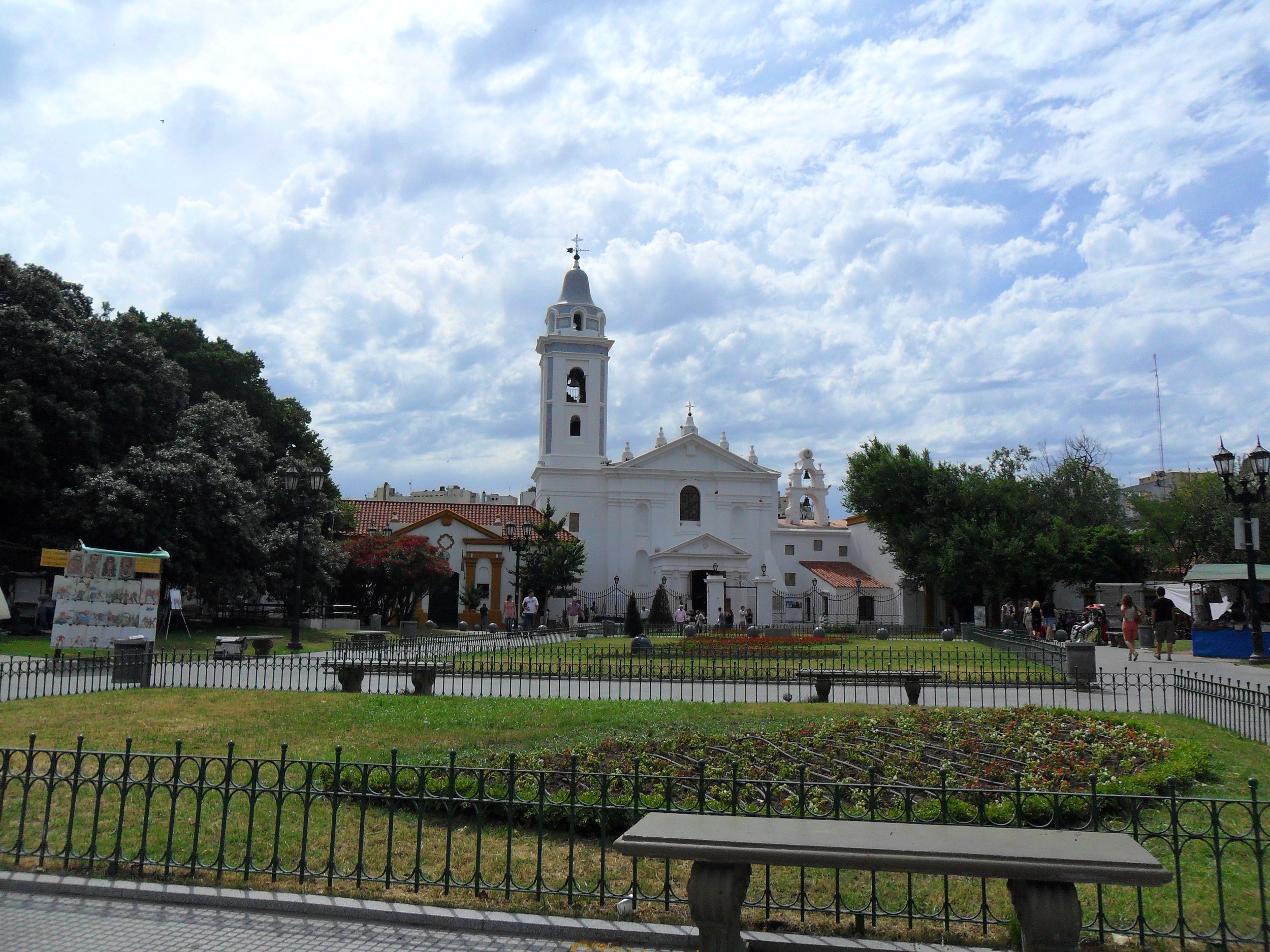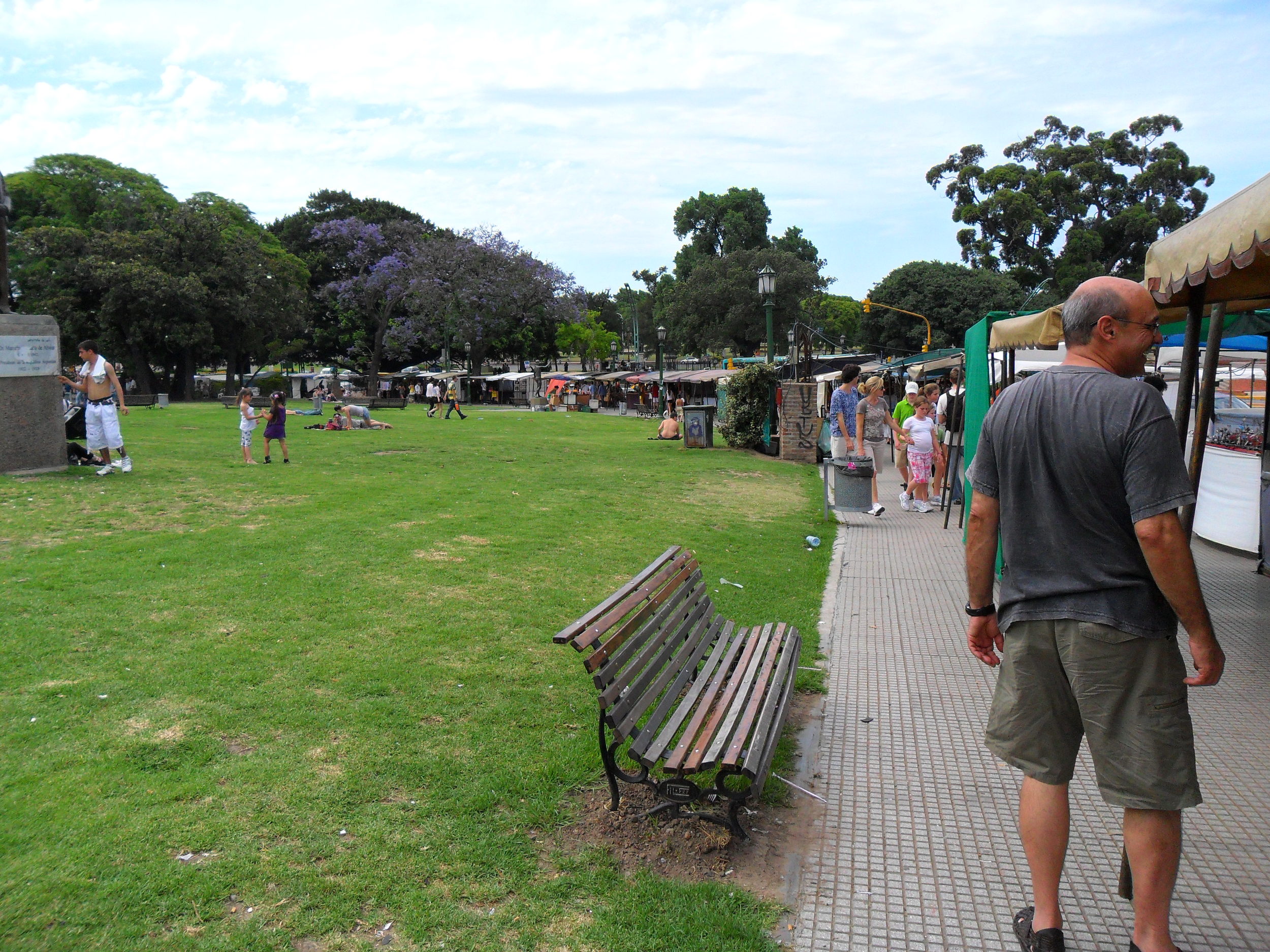I meant to blog from Buenos Aires, but forgot my blog password (so much for automatically logging in from a different computer).
Although this was my fourth trip to Buenos Aires, it had been a long time since #3. I was eager to spend more time in one of my favorite cities. I was excited about getting to dance seven days a week. I was scheduled for a bunch of private lessons with my favorite teachers, Oscar Mandagaran and Georgina Vargas, and I felt ready to bite off a new chunk of technique.
I accompanied a friend on this trip, so our choice of milongas was a combination of looking for high quality dancing, low numbers of tourists, and an older clientele who would ask women to dance who were older than twenty ;-)
My choices for milonga attendance were also based on looking for the older dancers who started to dance before dance classes were popular. So many of my teachers have died in the past ten years (this year, Omar Vega and Tete, as well as a few of the milongueros I like to dance with), that I wanted to learn as many steps, tricks, and personal style details as I could by dancing with "the geezers" while they were still around to dance with me.
As the popularity of milongas changes constantly, we relied on advice from our teachers, friends and other dancers to decide where to dance each night. What follows is a synopsis of where we danced and what I liked/disliked about those venues.
Porteno y Bailarin, Riobamba 345, 11 PM to 3 AM
(Tuesday)
Porteno y Bailarin is only a half block away from Avenida Corrientes and 1.5 blocks from the Callao subte (subway) stop, tons of bus lines and millions of taxis, as far as I can tell. It's centrally located and easy to get to. Cost: 18 or 20 pesos (sorry, I forget!).
Why we went there: I knew that this would not be the crowd we were looking for, but Jose Garafolo (the organizer of P y B) was one of my first teachers, and I wanted to say hello. II enjoyed catching up on the last few years and dancing a VERY fun tanda with him; I wish I had had time to go back and dance there again.
Who was there: This crowd had more foreigners than most of the places we went; perhaps 40-50%. It was a mixed bag of ages, from very young to tottering. There were a few hotshots doing open embrace, many close embrace dancers (square and V embraces), and a few who combined both styles as space permitted. The floor was not very crowded, but it still took navigational skills to dance there because of the small floor size.
How did the evening go: It helped to be greeted with enthusiasm by the host: we started dancing almost immediately. A few men thought I looked familiar and invited me to dance. After I danced a set with Jose later in the night, I didn't sit down much until we left.
Notes: The space was small enough to see almost everyone in order to cabeceo(for those of you who don't invited others to dance with this eye
contact and nonverbal invitation: you aren't going to dance very much
in Bs As unless you practice!). It was a bit dark, compared to many of the other milongas we attended, so I needed to put my glasses on each time I sat down to make eye contact ;-)
Other places to dance on Tuesdays (recommended by my teachers): Maipu 444, from 7 PM to 1 AM (see review below).
Maipu 444, 7 PM to 1 AM
(Tuesday)
Maipu 444 is close to the Florida subte stop, or the Pellegrini/Diagonal Norte/etc. stop at the Obelisco. It is of course bus and taxi friendly as well. Right downtown, you can go shopping on Calle Florida just a block away if you get there early.
Why we went there: Several friends recommended Maipu 444, and I was curious, as this milonga had not been open the other years I had gone to Bs As.
Who was there: This crowd had some foreigners, but was mostly Argentine, most from age forty on up.
How did the evening go: We had been advised to go early (I suggest reservations here for sure), so we showed up before 8 PM and got decent seats along the front edge. Both of us danced a lot that evening, despite the challenge of a few "pods" of men who would look at us, and then look away for the first few hours. The floor is small enough to be able to cabecear almost anyone in the room (we were at the opposite end from the bar, and there were a few tables at that far end where we could barely see the occupants enough to tell if they were asking us to dance). The lighting is good. The people were nice. The level of dance was variable, and we found that many of the men were at a lower dance level than we were! I'm not used to Argentine men apologizing for their lack of dance level--this was new to me.
Notes: Go early, or you won't get a table. Also, there is a very yummy pizzeria nearby, on Corrientes as you head towards the obelisk (Palacio de Pizza?) with delicious baked things and flan to die for.
La Nacional, Alsina 1465, 8 PM to 2 AM
(Wednesday)
La Nacional recently reopened, and it was great to see how much nicer they have made this space, especially given the lovely (but slippery, so beware!) floor. This milonga is in the Congreso area, walkable from San Telmo or the Corrientes corridor; near the Congreso subte line and, of course, buses and taxis.
Why we went there: Oscar and Georgina recommended this milonga as a place with good dance level, good floorcraft, and good manners. Also, the seating is men on one side, women on the other, with mixed tables for couples and groups on the ends. This makes it easier to see potential partners, and makes for more possibilities for dancing.
Who was there: This crowd had foreigners mixed in, but I danced almost exclusively with Argentine men. One or two dancers opened up into bigger moves when there was room, but almost everyone stuck to close embrace dancing (both square and V embraces).
How did the evening go: This was one of the most enjoyable places I danced. Even the first night, I didn't sit out very much. We were placed in the third row back of chairs, but both of us are experienced at cabeceo, and managed to get invitations even when being blocked by the ladies in front. Some of the men who invited me to dance that night frequented many of the other places we danced, so I began to build my dance card.
Notes: The floor is quite long, and it is harder to catch the eye of men on the ends of the space if you are in the middle. HOWEVER, being in the middle of the long sides of the room is much better than being stuck in a corner. The floor is slippery, so bring your shoes with suede bottoms! Even with shoes wetted with water, you will slide here if you are not careful. Make reservations with Atilio Veron, the organizer, if you want a nice seat: 15-5963-1924.
Other Wednesday night milongas that came well-recommended: La Milonga, Humberto Primo 1462 (where Nino Bien is on Thursday nights), 6 PM to 2 AM; Sueno Porteno, San Juan 3330, from 7 PM to 3 AM.
Lujos, Riobamba 416 (El Beso)
(Thursday)
Even though the name of the milonga on Thursdays is Lujos, almost everyone just called the space El Beso. It is a few doorways away from Avenida Corrientes
and 1.5 blocks from the Callao subte (subway) stop, tons of bus lines taxis. It's centrally located
and easy to get to.
Why we went there: My teachers said that the level of dance on Thursdays was very high. Years ago, I frequented El Beso with Tete's vals class (we ate dinner after class and went to El Beso each week). In addition, my friend had heard of El Beso, and it was on her list of places she wanted to dance.
Who was there: Tons of Italians, and a lot of portenos, with a sprinkling of a few other foreigners. Mostly the forty to seventy year old crowd showed up, although with face lifts, I figured out ages from the wrinkles on women's backs!
How did the evening go: I felt like a piece of wallpaper. We got stuck in the back row, against the back wall. Because of the shape of El Beso, there is NO space for the tango sharks to circle, looking for partners, except near the entrance and the bar (the other side of the room). Men who happily danced with me at other venues looked right through me at El Beso: not a regular? Forget it. I got some mercy dances from nice guys I already knew, but apart from that, I had to wait until the second or third song of a tanda to get invited to dance. When I described the evening to friends, they said, "Si, El Beso, es un lugar MUY exclusivo" and explained that it was important to be seen there dancing well, so folks didn't take as many risks inviting unknown partners to dance.
Notes: El Beso was the darkest place we danced, and it was difficult to make eye contact across the floor, even though the floor is not large. Take a group with you, or be pushy and try to get a front row seat. I didn't notice that the level of dance was higher than elsewhere, but El Beso has that reputation.
Other recommended places to go on Thursdays: Nino Bien, Humberto Primo 1462 (see review below), from 10:30 PM to 4 AM; and La Cachila, La Rioja 1180 (Club Gricel), from 8 PM to 3 AM (see review below).
La Cachila, La Rioja 1180 (Club Gricel), 8 PM to 3 AM
(Thursday)
Go to Gricel on the bus or by taxi. It's a bit further out than some of the more central milongas, but it should not run you more than 12-20 pesos, unless you are way out in Palermo or Recoleta.
Why we went there: We promised to meet friends, and so went back to Gricel, despite mediocre experiences there the week before (on another night).
Who was there: This was mostly an older crowd (I'd say 50+), with some foreigners, but mostly Argentines out in force.
How did the evening go: This was one of my few experiences in Bs As of becoming one with my chair. We were placed in the back row of a front table, despite the protestations of the Argentine woman in the front row, who had hoped to keep the seats for friends, despite not having made reservations. We had a chilly reception at best. We could see five or six men from where we were seated, most of whom were foreigners also relegated to the corner. After dancing with them, we pretty much sat until giving up. Our friends didn't show by 9:30, so we left for Nino Bien (see below), which happily made up for this early evening experience as a piece of sculpture.
Notes: Gricel is not my favorite venue. It is a bit dark sometimes, and it's hard to see down the sides of the floor due to the pillars between tables. It's easy to see across the room, but not with dancing couples, so you have about one minute to score a dance at the beginning of the tanda, and then you will probably sit until the next tanda.
Nino Bien, Humberto Primo 1462, 10:30 PM to 4 AM
(Thursday)
Nino Bien is a long-running, famous milonga. It has been my choice for Thursday evenings for all of my trips to Bs As; so it was wonderful to walk in on a Thursday evening, greet Luis (the organizer, who looks exactly like he did when I first went there in 1999), and settle in for an evening of dancing.
Why we went there: We tried Gricel earlier in the evening, and had been seated in a horrible place, with almost no men in sight. I looked at my friend and said, "Let's go to Nino Bien" and off we went. We wanted to DANCE! and I knew we would at NB.
Who was there: Everyone was there, old, young, foreigners, regulars, even a camera crew who were filming for something (it was not explained, nor was it obvious).
How did the evening go: Great! We both recognized a lot of people from other milongas, and danced with them. However, we also got invited to dance by men we'd never seen before. By the time we left (right before a milonga set), I'd been asked to save the next milonga set for a specific guy--by four different men! If my feet hadn't been done (too much shopping and milonga #2 for the night), I would have stayed to figure out who to dance with.
Notes: Order dinner at Nino Bien! I had the best calabaza torta (squash quiche-like thingie) that I have EVER tasted. There weren't many choices, but we noticed that many early comers had ordered dinner, and so were encouraged to give the menu a try. Lovely! The difference between dancing at this venue in the "afternoon" and "evening" mainly seemed to be the steering skills of the dancers. Almost no one crashed in the afternoon milonga, but in the evening, I had several people run into me, and had one partner run into another couple. The level of correct manners is higher in the earlier dancers, too.
Entre Tango y Tango, Humberto Primo 1462, 6 PM to 2 AM
(Friday)
Entre Tango y Tango is at the same place that Nino Bien is held Thursday nights. It is walkable from San Telmo or Congreso, but be aware that I saw streetwalkers in pretty much every direction from the building after the sun went down; you may prefer to take a taxi! It's easy to get to by bus or taxi, and the subte is not far away.
Why we went there: I had heard from many of the men I danced with, that this was the best place to go on Fridays. As my friend had stomach flu (I succumbed a day later), I went by myself. I wanted to dance where my teachers said the best level of dance and floor craft were.
Who was there: I was one of the youngest people at this milonga, but there was a fair mix of 30- to 70- (or 80-) somethings. Many were from Bs As, although I saw the Italians from the night before, a few Japanese, and two Oregon guys there.
How did the evening go: I had been told to go early to get a good seat, so I arrived around 6:30 or 7 PM. I was given a front row seat at a table halfway down the room--choice territory. I danced almost every single tanda the entire evening. I was joined by three French ladies at some point, and gamely tried to keep my Spanish and French segregated into separate languages, one for dancing, and one for my table. I left around 11:30 only because I had promised to meet a friend at another dance; otherwise, I would have stayed until it closed. This was one of my most enjoyable evenings of the trip.
Notes: I love Nino Bien's dance space. I know it by heart from months of dancing there, so it feels like home to me. The floorcraft is great, if you avoid the middle row, who play chicken with the oncoming traffic. The floor is one of the best in Buenos Aires, the room is elegant, and the clientele polite but not snooty. I owe a debt of gratitude to the kind waitress who gave me change for the taxi (I tipped her well at the other milongas where I saw her after that).
Paracultural Salon Canning, Scalabrini Ortiz 1331, 11 PM to 5 AM
(Friday)
Salon Canning is only a few blocks off of Avenida Cordoba. It's almost a 20 peso taxi ride from San Telmo/Congreso, but there are many buses that can take you across the city for much cheaper (1.10 pesos at this moment).
Why we went there: I was meeting a friend I had not seen for ten years. Since I had elected not to get a local cell phone, our communication had been spotty, but I figured I'd look for him and dance for a bit if he didn't show up.
Who was there: This crowd was quite different from the one at my usual milongas (a friend had labeled my choices "the geezer milongas"). Many of the crowd were 20- or 30- something, mixed in with the regular up to 80-somethings. There were a LOT of foreigners. There were people trying to dance open embrace in a space designed for close embrace, and there were quite a few traffic issues on the dance floor at any given time.
How did the evening go: The air conditioning was broken that night (someone told me it had burned up?), and it was HOT and HUMID. It was so humid that pivoting one's shoe on the dance floor was difficult--and this is one of my favorite dance floors in Bs As! I came back from my first tanda to find my friend seated at the next table, by coincidence, so I was able to catch up with him and continue to dance with other men. This was the only place I danced where most of the people who invited me to dance were foreigners.
Notes: The evening milongas are a different beast than the "afternoon" milongas that usually end around midnight. I've done the evening thing for a few visits to Bs As, and decided not to follow that route this time, in order to focus more attention on my private lessons. It felt good to be back in my old routine for an evening, but I found that I prefer dance with the "geezers" more than with beginner- to intermediate-level Europeans.
Other places to dance Fridays that are recommended by friends/teachers: Lo de Celia Tango Club, Humberto Primo 1783, 10 PM on; Sin Rumbo, Jose Tamborini 6157, 10 PM to 4 AM (out in Villa Urquiza, "nice for a group or a couple"); and La Baldosa, Ramon L. Falcon 2750.
La Nacional, Alsina 1465, 8 PM to ? (brand new milonga)
(Saturday)
As I mentioned above, La Nacional is easy to get to on foot, by bus or taxi, and relatively near the subte.
Why we went there: I was out of commission with the 24-hour version of a stomach flu our first Saturday night, but my friend attended La Nacional with some other friends of ours. Despite having a less than stellar night the first time (she estimated that it was 3- or 4- to 1 ratio of women to men), we chose to go back the next weekend, in order to meet friends and go out to eat afterwards.
Who was there: The Saturday I attended, many of the dancers were Argentine, sprinkled with a few French and Italians, as well as a few Americans (mostly us and our friends). The age range probably started at 30- or 40-, but most dancers were probably in the 50-70 range, with an enthusiatic 80-something pointed out to our table.
How did the evening go: I was not in the mood to put myself out and invite dances that night, so I sat in the back row of our table with three Argentine women, and gossiped until they huffily left for other milongas ("Why should we pay 18 pesos to get in, and then not get to dance?!" exclaimed one of them as she left). The male-female ratio was much closer to 50-50 than the week before, and many dancers were now familiar, so my friend danced a lot, and I danced when I felt like dancing.
Notes: Again, beware of the slippery floor! This is a good place to use small steps, even if it is big enough to have space to really MOVE. At no time was the dance floor so crowded that it made dancing difficult, but one foreigner told me he felt intimidated by the lack of space, so take or leave my opinion. They have good empanadas and tostados if you get hungry.
Other places to dance Saturdays: Saturday is traditionally date night, so you often see folks you thought were single, showing up with wives and husbands, or dates. When I was spending longer periods of time in Bs As before, I usually chose to go salsa dancing on Saturday nights, or to go out for dinner with non-tango friends. However, if you are on a short timeline, or just can't stop for an evening, have no fear, dance is still available: Cachirulo, Maipu 444, from 6 PM to 3 AM (according to books, but at 7:30 PM, there was still no music playing when we stopped by to check it out before going to La Nacional); Milonga de las Morochas, Riobamba 416, from 10:30 PM on (I used to go to this in years past); or Lo de Celia Tango Club, Humberto Primo 1783, from 11 PM to 4 AM.
Torcuato Tasso, Defensa 1575, 10 PM to 3 AM
(Sunday)
Torcuato Tasso was my old stomping grounds, being the nearest milonga to where I used to stay in San Telmo, back in the old days. This milonga is no longer free on Sundays, as of a few months ago :-( but our teachers said they were going there, so we joined them.
Who was there: This was the most mixed group we encountered, all the way from non-dancers who were goggling at the dance floor from their tables, to teenagers in jeans, to full suits and spiffy shoes on older dancers, to tables of foreigners. The level of the dancers also varied from pitiful to amazing.
How did the evening go: This was a very uneven evening. I danced with a young Canadian who was a very new dancer; some Argentines who had danced for many years, but were definitely intermediate; and my teacher, who is one of the best dancers I've ever encountered (maybe the best). I had never encountered an Argentine who yells one's name across tables to dance because of being situated BEHIND me--I ended up ignoring him because it annoyed me, but accepted a very fun chacarera set with him later.
Notes: Torcuato Tasso's floor has not improved over the years: it is still rock or polished cement, or some other surface that gets nasty when wet and makes your feet hurt (funny, I never cared about that ten years ago!). I still like the space because it has so many memories for me. I once danced right next to Shakira on this dance floor, and one of my two witnessed fights on tango dance floors happened here, too. If you are looking for a good dance experience, this is not a sure bet.
Other places to dance on Sundays: A Puro Tango, Scalabrini Ortiz 1331, from 6 PM to 1 AM (see review below); La Milonga de Susana, Ramon L. Falcon 2750, from 6 PM on; El Beso, Riobamba 416, from 10 PM on; and Porteno y Bailarin, Riobamba 345, later on.
A Puro Tango, Scalabrini Ortiz 1331, 6 PM to 1 AM
(Sunday)
Again, Salon Canning is easy to get to by taxi or bus, but it's a walk from the subway.
Why we went there: My friend had not come with me to Salon Canning the Friday before, and she wanted to see the famous milonga. It was our last night in Bs As, and I thought we would be able to get some good dancing in.
Who was there: This crowd seemed to be almost completely Argentine, apart from the gorgeous Brazilian girl and her boyfriend who came in to watch and got dragged onto the floor to try tango (for the first time, I would guess). The age of my dance partners averaged around 60+ and most of the folks there were dressed nicely and started to clear out around midnight to go home.
How did the evening go: This was one of my best dancing nights in Bs As. I had one of the best Pugliese tandas of my entire Bs As career that night, with a quiet, older man who seemed either embarrassed or taken aback when I told him that. The level of dance was better than many of the places we had gone, but the level of "pickup" was higher: in several cases, I considered ending the tanda early because of the deep interest my partner was displaying in me (and not my dance, I don't think). I also had a great chacarera set (three! not two! three chacareras!), which is always a highlight for me, the former crazed international folk dancer.
Notes: This was one of my favorite places to go to "afternoon" dances when I frequented Bs As in the early 2000s, and it still is. Even sitting in the last row before the shark circling area, we barely sat down the entire evening. If you can dance well, you will get to dance here. Over and over and over.
Lunes de Tango, La Rioja 1180 (Club Gricel)
(Monday)
Lunes de Tango is at Club Gricel, which is a bit further out than the other milongas we attended (up to Plaza Miserere and hang a left). It is reachable by bus or taxi, but I wouldn't walk it if I were you.
Why we went there: Mondays are a day with fewer milongas, but we still had two possibilities that were suggested. We agreed to meet our teachers there, but ended up sitting at a women's table, while they sat together at a couple's table.
Who was there: This crowd was mostly Argentine, with a few Americans, Italians, French and one Spanish guy who kept appearing wherever we danced (nice dancer, actually!). The age range was pretty much on the older side, with most folks looking 50-70ish.
How did the evening go: This was not our best evening, but we had pleasant women at our table (Argentines), a table of guys on each side who ended up dancing a lot with us, and a position at one of the entry/exit points for the floor, so the men who wanted to dance with us knew where we were.
Notes: Gricel is long and skinny, with pillars around the edge of the dance floor. This makes it much harder to make eye contact with about half the tables, so, unless you are strategically placed, you have to make so with those you can see. There is space to circulate between the floor edge tables and the ones along the wall, so some men do the shark circling thang, but I still had no idea who was at the other end of the room.
Other places to dance on Mondays: Parakultural Canning, Scalabrini Ortiz 1331, from 11 PM to 4 AM.

